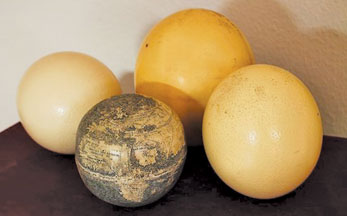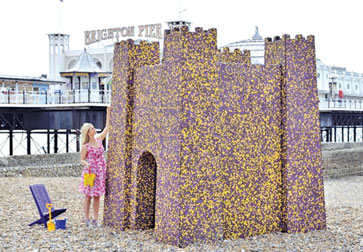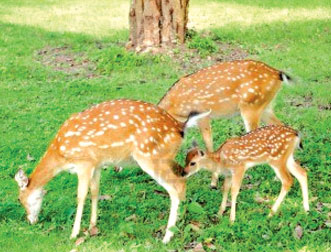|

Oldest world map engraved on ostrich egg
 |
|
If new research is correct, then the
small, unnamed island shown to the far north in the “Mundus
Novus” portion of the egg-globe’s western hemisphere is the
earliest image of Newfoundland or any other part of Canada
on any surviving globe in the world. |
The new world discovered by explorers such as Christopher Columbus
and Amerigo Vespucci engraved on an ostrich egg was found recently,
according to a Washington Map Society news release.
This report of an exciting discovery for cartographic historians: an
ostrich-egg globe purchased last year at the London Map Fair is now
believed to be the oldest to show any part of the New World.
Dated to the early 1500s, the globe was likely crafted in Florence,
Italy, from the lower halves of two ostrich eggs. It is also decorated
with monsters, intertwining waves and even a shipwrecked sailor,
according to the Washington Map Society, which published a study of the
artefact in its journal The Portolan.
“When I heard of this globe, I was initially sceptical about its
date, origin, geography and provenance, but I had to find out for
myself,” Stefan Missinne, an independent Belgian research scholar, said
in a statement. “After all no one had known of it, and discoveries of
this type are extremely rare. I was excited to look into it further, and
the more I did so, and the more research that we did, the clearer it
became that we had a major find.”
The anonymous owner of the globe, who bought it in 2012 at the London
Map Fair, allowed Missinne to investigate the globe.
The researcher used carbon dating, computer tomography testing, an
ink assessment, as well as a geographical, cartographic, and historical
analysis.
He determined that the grapefruit-sized globe was made around 1504
and was likely used to cast the famous copper Lenox globe housed at the
New York Public Library, which, until now, had been thought to be the
oldest globe to show the Americas, dated to 1510.
“This is a major discovery, and we are pleased to be the vehicle for
its announcement,” Tom Sander, editor of The Portolan, said in a
statement. “We undertook a very extensive peer review process to vet the
article, which itself was based on more than a year of scientific and
documentary research.”
 The only three names shown in South America are Mundus Novus (“New
World”), Terra de Brazil, and Terra SanctaeCrucis (“Land of the Holy
Cross”). The only three names shown in South America are Mundus Novus (“New
World”), Terra de Brazil, and Terra SanctaeCrucis (“Land of the Holy
Cross”).
Though the maker of the globe remains unknown, Missinne suspects the
globe may be linked to the workshop of Leonardo da Vinci. The researcher
noticed some similarities between a ship on the globe and the artwork of
an artist well acquainted with Leonardo.
In Missinne’s article, which touts the ostrich-egg artefact as the
“earliest surviving globe showing the New World,” the Austria-based
collector-researcher states that he “initiated research into the globe
because I was sceptical about its date, origin, geography, and
provenance.”
But a year’s probing of the object, including consultation with
dozens of experts and scientific tests to confirm the composition and
age of the eggshell, led Missinne to conclude that it was an authentic
16th-century globe that served as the template for the Hunt-Lenox
sphere, which has been accepted by scholars until now as the earliest
known globe showing the Americas.
Missinne particularly cited the support of Rudolf Schmidt, former
president of the International Coronelli Society for the Study of
Globes, who “was convinced that this globe was ancient and not a product
of the nineteenth or twentieth century. At this meeting it was also
established that there is a very close similarity between the
ostrich-egg globe and the (Hunt-)Lenox Globe.”
Chocolate castle on Brighton Beach
How would you like to live in a castle, made from chocolate?
 It may be like a scene from a fairy tale where a beautiful princess
and a handsome prince living forever in a chocolate palace! It may be like a scene from a fairy tale where a beautiful princess
and a handsome prince living forever in a chocolate palace!
But this castle is a real one built by the famous British chocolate
company - Cadbury’s.
The chocolate castle found on the Brighton beach was built using
90,000 of dairy milk pebbles. It was how Cadbury’s celebrated the recent
bank holiday.
Thousands of sugar-coated chocolate bites had to be placed on the
outside of a specially-constructed model by five people, who worked for
100 hours collectively.
‘We just wanted to do something special for the bank holiday for
families and to add a touch of extra fun for Cadbury World,’ said a
spokeswoman.
‘We shot it at Brighton as a nod to their pebbly beach so it was
displayed there for a bit then made its way to its ‘home’ in Bournville,
Birmingham - a little pit stop.’
Cadbury may want to keep the Dairy Milk pebble castle under
observation otherwise they may find someone has taken a bite out of it.
Thousands of deer take over Japanese city
Sikae deer once thought of as heavenly animals, and now treated as
one of Japan’s national treasures have invaded the Japanese town of Nara
in their thousands.
 As Nara is home to a herd of over 1,000 of Sikae deer the city is
virtually overrun with them. As Nara is home to a herd of over 1,000 of Sikae deer the city is
virtually overrun with them.
Buses and cars running through the city streets are seen inching
their way past the animals.
While some pedestrians stop to take photographs of the deer, others
walk past without giving them a second glance. One viewer said: “Nara is
my home city, it is not uncommon to see the sikae all over town. I often
see them in my garden at night. We are quite proud and protective of our
deer here in Nara!”
One tourist was less impressed, however: “I got bitten by one in May
when I refused to give it one of the packets of biscuits that are on
sale everywhere to feed them. They can be quite aggressive.”
Another seemed concerned about hygiene: “Some of these deer carry
deer ticks. Those deer ticks carry disease that can be transmitted to
humans.
“This is the height of recklessness by the Japanese authorities who
value tourists dollars over public health. |


